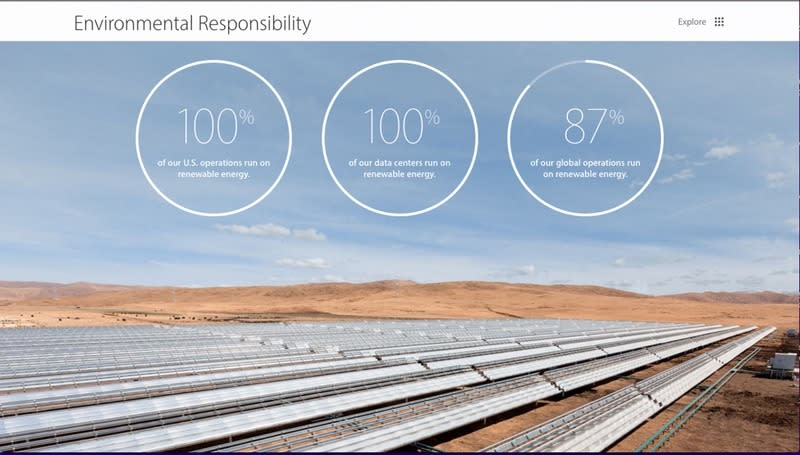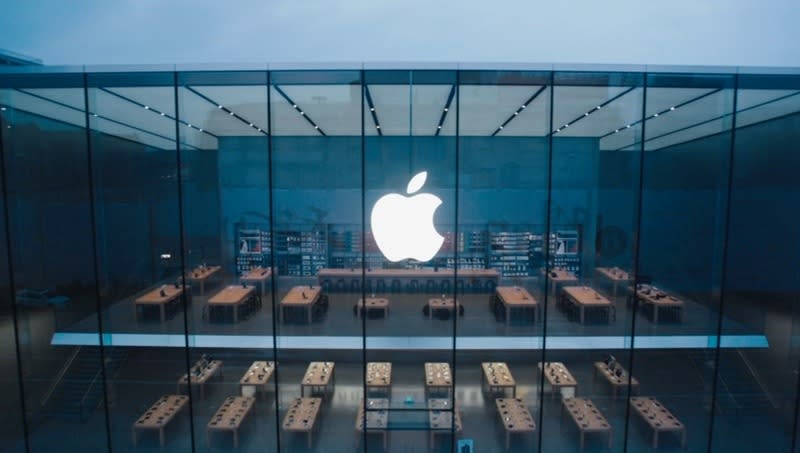Apple’s making good on its environmental promises, but are they enough?

Apple’s events typically lead off with a recitation of all the stuff the company has sold. But at Monday’s introduction of the iPhone SE and the 9.7-in. iPad Pro, the company started by talking about all the stuff it hasn’t used.
“We want to change the world for the better, and we think there’s no greater challenge in the world than our changing climate,” said Lisa Jackson, Apple’s vice president for environment, policy and social initiatives.
Jackson, who was an administrator of the Environmental Protection Agency from 2009 to 2013, spent the next eight minutes touting such recent Apple environmental achievements as powering 100 percent of its U.S. and Chinese offices and stores with renewable energy that puts no new carbon dioxide into the atmosphere to fuel global warming.
Worldwide, 93 percent of the Cupertino, Calif., company’s facilities run on renewable energy — close to the 100 percent goal it set two years ago. Those figures, however, exclude the third-party manufacturing facilities that Apple relies on and which contributed 24.8 million metric tons of the 34.2-million metric-ton carbon footprint the company reported for 2014.
Jackson’s presentation included such unexpected sights as a new 40-megawatt solar plant in China that accommodates grazing yaks underneath and a robot named Liam that dismantles old iPhones, one screw at a time. (Your own iPhone has already had nightmares about him.)
Not a new thing
It’s easy to read this outburst of public-spiritedness as another sign of a changing Apple under CEO Tim Cook.
But Steve Jobs first began talking up the company’s sustainability efforts in 2007, when he posted a letter (gone from Apple’s site, preserved at the Internet Archive) admitting that its habit of opacity had “left our customers, shareholders, employees and the industry in the dark.”
Three years later, Greenpeace — the environmentalist organization that had chastised Apple in 2007 for its apparent apathy, leading to Jobs’ letter — was holding up Apple as an example for competitors.

The rest of the industry has been busy, too. Google, for example, says its data centers use half as much electricity as typical facilities, while 37 percent of the company’s facilities run on renewable energy. It’s also invested in “moon shot” projects like Makani “energy kites” that would make wind power easier to generate.
Facebook, for its part, open-sourced its data-center power-conservation efforts under the Open Compute Project; you can look up real-time reports about the efficiency of its facilities at its Green on Facebook page.
And Microsoft says its operations have been 100 percent carbon-neutral since June 2012. Last week, it announced its own new solar plant, a 20-megawatt facility in Remington, Va., to be built with Dominion Power.
These companies all have sound economic reasons to cut down on energy use: Data centers have large electric bills. Tighter packaging can yield major shipping-cost savings. As Apple vice president Greg Joswiak told me at a 2010 briefing about new iPods: “You never want to ship air.”
What else could be done
In some ways, Apple lags behind competitors in the greening of America. For example, Apple Maps remains woefully car-centric: Its limited transit navigation still doesn’t cover Atlanta, Dallas, Denver, and Seattle, among many other U.S. cities, and it doesn’t provide bicycling directions anywhere.
And Apple shares the habit of many large tech firms by building its offices out, not up. Sprawling corporate campuses, unlike more vertical headquarters such as Twitter’s San Francisco building and Amazon’s cluster of structures in Seattle’s South Lake Union neighborhood, make it harder to get to work by transit or on foot.
But the real shortcoming in Apple’s green-tech initiatives is that the bulk of the problem lies elsewhere.

As a 2013 report by the Natural Resources Defense Council found, data centers remain inefficient when you look past the Apples and Googles of the industry. But combined they still constitute only about two percent of the electricity used in the U.S.
Electricity, in turn, only makes up a little over a third of America’s carbon dioxide output, according to EPA statistics.
“The fact that they’re taking leadership in their own area is very positive,” said Pierre Delforge, the NRDC analyst who wrote that 2013 report. “The next frontier is trying to take this beyond their own area and their own impact.”
Apple has taken a few cautious steps into environmental-policy advocacy. In 2009, it quit the U.S. Chamber of Commerce to protest that industry group’s climate-change obstructionism. (The Chamber now says it backs “sensible approaches to reducing greenhouse gas emissions” but doesn’t want the EPA to do much of anything about that.)
Delforge said he’d like to see Apple expand its state-level advocacy from arguing against discriminatory legislation — Cook denounced an Indiana “religious freedom” bill for legalizing prejudice against homosexuals — to pushing for environmentally-friendly laws like renewable-power requirements for power utilities.
“We’d like them to see them support policies that ensure it’s not just Macs that are energy-efficient,” he said.
But when much of a major American party is motivated by denial that human-caused climate change even exists, that may be too much work even for Apple.
Email Rob at rob@robpegoraro.com; follow him on Twitter at @robpegoraro.


